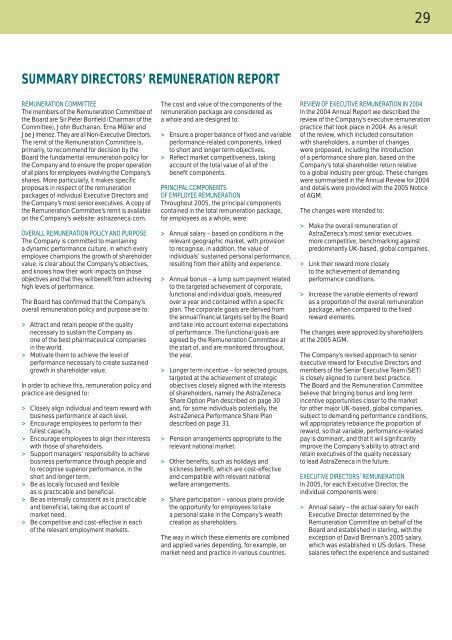AstraZeneca Annual Review 2005 - AstraZeneca Annual Reports
AstraZeneca Annual Review 2005 - AstraZeneca Annual Reports
AstraZeneca Annual Review 2005 - AstraZeneca Annual Reports
Create successful ePaper yourself
Turn your PDF publications into a flip-book with our unique Google optimized e-Paper software.
29SUMMARY DIRECTORS’ REMUNERATION REPORTREMUNERATION COMMITTEEThe members of the Remuneration Committee ofthe Board are Sir Peter Bonfield (Chairman of theCommittee), John Buchanan, Erna Möller andJoe Jimenez. They are all Non-Executive Directors.The remit of the Remuneration Committee is,primarily, to recommend for decision by theBoard the fundamental remuneration policy forthe Company and to ensure the proper operationof all plans for employees involving the Company’sshares. More particularly, it makes specificproposals in respect of the remunerationpackages of individual Executive Directors andthe Company’s most senior executives. A copy ofthe Remuneration Committee’s remit is availableon the Company’s website: astrazeneca.com.OVERALL REMUNERATION POLICY AND PURPOSEThe Company is committed to maintaininga dynamic performance culture, in which everyemployee champions the growth of shareholdervalue, is clear about the Company’s objectives,and knows how their work impacts on thoseobjectives and that they will benefit from achievinghigh levels of performance.The Board has confirmed that the Company’soverall remuneration policy and purpose are to:> Attract and retain people of the qualitynecessary to sustain the Company asone of the best pharmaceutical companiesin the world.> Motivate them to achieve the level ofperformance necessary to create sustainedgrowth in shareholder value.In order to achieve this, remuneration policy andpractice are designed to:> Closely align individual and team reward withbusiness performance at each level.> Encourage employees to perform to theirfullest capacity.> Encourage employees to align their interestswith those of shareholders.> Support managers’ responsibility to achievebusiness performance through people andto recognise superior performance, in theshort and longer term.> Be as locally focused and flexibleas is practicable and beneficial.> Be as internally consistent as is practicableand beneficial, taking due account ofmarket need.> Be competitive and cost-effective in eachof the relevant employment markets.The cost and value of the components of theremuneration package are considered asa whole and are designed to:> Ensure a proper balance of fixed and variableperformance-related components, linkedto short and longer term objectives.> Reflect market competitiveness, takingaccount of the total value of all of thebenefit components.PRINCIPAL COMPONENTSOF EMPLOYEE REMUNERATIONThroughout <strong>2005</strong>, the principal componentscontained in the total remuneration package,for employees as a whole, were:> <strong>Annual</strong> salary – based on conditions in therelevant geographic market, with provisionto recognise, in addition, the value ofindividuals’ sustained personal performance,resulting from their ability and experience.> <strong>Annual</strong> bonus – a lump sum payment relatedto the targeted achievement of corporate,functional and individual goals, measuredover a year and contained within a specificplan. The corporate goals are derived fromthe annual financial targets set by the Boardand take into account external expectationsof performance. The functional goals areagreed by the Remuneration Committee atthe start of, and are monitored throughout,the year.> Longer term incentive – for selected groups,targeted at the achievement of strategicobjectives closely aligned with the interestsof shareholders, namely the <strong>AstraZeneca</strong>Share Option Plan described on page 30and, for some individuals potentially, the<strong>AstraZeneca</strong> Performance Share Plandescribed on page 31.> Pension arrangements appropriate to therelevant national market.> Other benefits, such as holidays andsickness benefit, which are cost-effectiveand compatible with relevant nationalwelfare arrangements.> Share participation – various plans providethe opportunity for employees to takea personal stake in the Company’s wealthcreation as shareholders.The way in which these elements are combinedand applied varies depending, for example, onmarket need and practice in various countries.REVIEW OF EXECUTIVE REMUNERATION IN 2004In the 2004 <strong>Annual</strong> Report we described thereview of the Company’s executive remunerationpractice that took place in 2004. As a resultof the review, which included consultationwith shareholders, a number of changeswere proposed, including the introductionof a performance share plan, based on theCompany’s total shareholder return relativeto a global industry peer group. These changeswere summarised in the <strong>Annual</strong> <strong>Review</strong> for 2004and details were provided with the <strong>2005</strong> Noticeof AGM.The changes were intended to:> Make the overall remuneration of<strong>AstraZeneca</strong>’s most senior executivesmore competitive, benchmarking againstpredominantly UK-based, global companies.> Link their reward more closelyto the achievement of demandingperformance conditions.> Increase the variable elements of rewardas a proportion of the overall remunerationpackage, when compared to the fixedreward elements.The changes were approved by shareholdersat the <strong>2005</strong> AGM.The Company’s revised approach to seniorexecutive reward for Executive Directors andmembers of the Senior Executive Team (SET)is closely aligned to current best practice.The Board and the Remuneration Committeebelieve that bringing bonus and long termincentive opportunities closer to the marketfor other major UK-based, global companies,subject to demanding performance conditions,will appropriately rebalance the proportion ofreward, so that variable, performance-relatedpay is dominant, and that it will significantlyimprove the Company’s ability to attract andretain executives of the quality necessaryto lead <strong>AstraZeneca</strong> in the future.EXECUTIVE DIRECTORS’ REMUNERATIONIn <strong>2005</strong>, for each Executive Director, theindividual components were:> <strong>Annual</strong> salary – the actual salary for eachExecutive Director determined by theRemuneration Committee on behalf of theBoard and established in sterling, with theexception of David Brennan’s <strong>2005</strong> salary,which was established in US dollars. Thesesalaries reflect the experience and sustained




